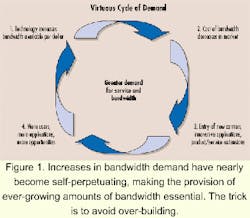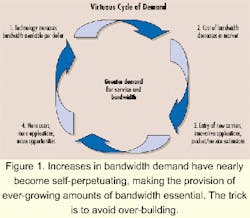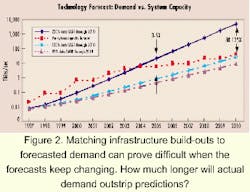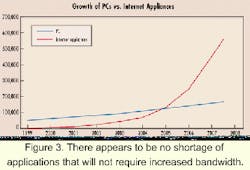Future of submarine networks in a turbo-charged business environment
Today's environment makes it difficult, but essential, to predict whether undersea infrastructures will fall short of or exceed bandwidth requirements.
S. HANSEN LONG, T Soja & Associates Inc.
The business environment of the new millennium has been described in many ways-the "New Industrial Revolution," "New Economy," "Information Economy," "Creative Economy," just to name a few. There is, however, another label that is descriptive and relevant to the telecommunications industry's turbulent, turbo-charged business environment. It is the so-called "Surge Economy," a term coined by Intel Corp. that appears in several of its recent magazine advertisements.
For example, in the Surge Economy, says Intel, "the only constant is change; more business is condensed into seconds than used to get done in a day." Another provocative feature of the Surge Economy is the notion that "the fear of failure has been replaced by the panic of success." In the pre-Internet business environment, companies feared that customers would not show up, says Intel. Now the main cause for panic is when they do...all together and in droves. For in the volume-dense Surge Economy, the pressure to perform has never been more intense, because "the problem isn't finding customers, it's what to do when they find you."
The telecommunications market faces this dilemma through its host of new customers seeking solutions to nontraditional communications problems created by a multiplicity of innovative applications totally unknown a few years ago. Meeting this challenge requires that telecom providers adopt new approaches to network planning. Principal among these is flexibility, for in the Surge Economy, the only way to thrive is to be flexible. Big bandwidth holdings by carriers and an abundance of redundant and diverse paths keep them flexible because service providers increasingly know less about where their customers will require new capacity.
By ensuring flexibility, carriers also respond to the other key imperatives of the Surge Economy, i.e., reacting quickly and decisively to rapid changes in the business environment ("business at the speed of thought"); exercising creativity by exploiting new information and new ideas and thus creating indispensable stores of intellectual property; and finally developing and retaining adaptability, the key to survival in the Surge Economy.
The reaction to the Surge Economy has created a surge in demand for undersea fiber-optic infrastructure. As with everything else in this new economy, measuring the strength of this demand is difficult-for both market analysts and infrastructure providers alike. The result is an environment where carriers can't be sure if they will have too much capacity or too little.
The turbulent business environment has been turbo-charged with a firestorm of demand sparked by market deregulation, the Internet, technology improvements, a multiplicity of new multimedia and broadband devices and applications, and the need for rapid global connectivity. To place this surge in proper perspective, it was scarcely four years ago that demand estimates for transatlantic and transpacific voice traffic began to approach the then unheard-of 100-Gbit/sec level.
Driven by spectacular improvements in both fiber and optical technology as well as the aforementioned increases in data demand, current forecasts are now well within the terabit-per-second range-and most recently, more visionary forecasts have dared to venture into the petabit-per-second range.The firestorm of demand is almost self-perpetuating. Technology increases the quantity of bandwidth available per dollar, thus decreasing the cost of bandwidth in the market. That provides the incentive for new carriers and other service providers to enter the market with innovative applications, products, and services, which in turn attract more users who demand more applications and services, thus producing what has been termed the "Virtuous Cycle of Demand" (see Figure 1).
Predicting this demand has been difficult, as the elements that compose it are changing rapidly. In previous years, when voice traffic was the dominant element, demand forecasting was straightforward and relatively easy. Because traffic was measured in annual minutes of usage, some reasonable growth factor was assigned to various circuit paths in assigned regions of the world and new demand forecasts were created with a relatively low margin of error. Today, however, the voice element and its quantifiable metric, minutes of usage, is rapidly decreasing as a percentage of total global telecom traffic. Data traffic and other packetized traffic generated by the Internet, multimedia, and other broadband services now predominate.
But therein lies the problem. Because the rapidly rising level of packetized data traffic between two points is circuitless, there is no coherent circuit-related measurement to gauge its growth and form the benchmarks needed for accurate forecasting. Thus, proxies must be created in the absence of quantifiable data and scenarios constructed on sets of reasonable expectations of traffic growth.
Proxies include measurable data such as in Internet user and host growth, Internet penetration rates, number of PC and non-PC devices by application, maximum bandwidth by application, predicted bandwidth usage per capita, and peak demand by time of day for residential and business users. Further, these proxy measurements must be projected within the context of breakthrough technologies, economic dislocations, and the virtually unpredictable effects of entrepreneurial ingenuity.
Yet, despite the lack of traditional metrics, demand forecasts of bandwidth usage are becoming more aggressive, as they are correlated with higher and higher predictions of Internet and data growth. Within the submarine network markets, these forecasts appear to break the industry's time-honored precedent of forecasting consistently below actual results achieved. This precedent is illustrated by a statement attributed to the TAT-8 Working Committee, which boldly predicted, "TAT-8 will be filled up in the year 2000." (The system actually filled in 1990.) In today's business environment, cable fill rates are shrinking dramatically, as customers contend for ever-increasing increments of circuit capacity, whole wavelengths and, now, whole fiber pairs; an unprecedented development for long-haul submarine cable systems.
Where will it end-this seemingly insatiable demand for greater and greater increments of bandwidth? Will there be a glut of capacity generated by an all-too-optimistic reading of Internet and data-demand growth? Will demand far outstrip planned capacity during the coming decade? Some answers appear in Figure 2, in which global demand projections are compared to the consensus global per-system capacity forecast through the year 2010.As can be seen, the per-system capacity forecast of today dwarfs the projected data forecast of 85% compounded annual growth rate (CAGR), which was the generally accepted figure appearing in articles published in mid-1997. It also exceeds the 100% data CAGR that was the generally accepted figure between 1998 and 1999. However, at the present time, the per-system capacity forecast appears to exceed what some would call a highly optimistic forecast of 200% data CAGR through 2004. That creates an apparent short-term excess that is quickly extinguished by 2005.
Judging by today's standards, a greater than 200% data CAGR is generally accepted-and if past history is any guide, it too may prove to be too low, and the apparent short-term excess will again vanish from the charts. Going beyond 2004, it is quite obvious that a 200% data CAGR again dwarfs the per-system forecast, exceeding it by a factor of 85 to 125 times in 2010. Is it too high, or will history repeat itself and cause us once again to rethink the true potential of the insatiable demand for bandwidth?It is instructive to note at this point that in the old consortium "Club" days, excess capacity builds in anticipation of future demand were not considered the wisest use of invested capital-a policy which tended to perpetuate consistently low forecasts of demand growth in line with a prudent balance sheet and an acceptable level of profit. In today's turbulent, turbo-charged economy, such thinking is in fact unthinkable! Being first to market requires early upfront investment. Asset accumulation (building capacity) is no longer just a necessary evil, but the first step to successfully securing market dominance in the Surge Economy.
Together with other telecom markets, the submarine-network market will be favorably affected by the unprecedented surge of demand now being generated across the broad spectrum of old and new users. During the next several years, submarine-network markets, driven by the anticipated need for enormous bandwidth capacity, will become truly global, reaching beyond the shoreline, connecting every major continent and backhauling city to city within every major geographical region.
Within the repeatered sector of the market, submarine networks will provide connectivity between multiterabit U.S., Asian, and European networks through integration of undersea and terrestrial systems. In addition, they will provide state-of-the-art broadband intercity services to carriers and service providers inter-regionally.
The unrepeatered sector will provide well-focused niche opportunities for regional interconnection with the international telecommunications infrastructure via the transoceanic and intra-regional cables within North and South America, Europe, the Middle East and Africa, India, and Asia.
In the coming decade, a multiplicity of PC and non-PC devices will feature a growing number of applications that will continuously absorb the global bandwidth transmitted by an increasing number of submarine-cable systems. Applications include:
- Audio downloads. Utilizing a variety of players with sales in the tens of millions.
- Audio streaming. 50% of Internet users in nine European countries surveyed have RealAudio installed on their PCs.
- Gaming Applications. A $205-million market, which composes about 5% of the software industry.
- Micro-cinema. The Internet is becoming a potent distribution channel and showcase, creating a direct connection between filmmakers and audience.
In addition, a large and growing number of non-PC Web-enabled devices will soon be the main source of accessing the Internet. For example, by 2005, sales of non-PC Internet devices in the United States are expected to surpass PC sales, according to market researcher IDC (see Figure 3). Twenty-six percent of Japanese advanced users have more than three Internet devices in their households versus 13% in the United States and 7% in the United Kingdom. Non-PC-based Internet devices, which include Internet screen phones, Internet gaming devices, Internet smart handheld devices, etc., are growing rapidly.
The future of submarine networks in today's market could not be brighter. Yet, there are challenges to maintaining a steady upward course as the industry enters the first decade of the new millennium. Perhaps the major challenge is one of mindset; recognizing that the market and customer expectations have changed dramatically in only a few short years. The industry must favorably serve an emerging group of new customers who are focused on robust network building at the least possible cost through the integration of both terrestrial and submarine cable systems.
Accordingly, suppliers must achieve transport cost improvements in a climate of ever-decreasing bandwidth prices and demanding delivery schedules. They must leverage rapid improvements in technology to achieve commonality between architecture, electronics, and services. They must address the trend by operators to integrate both their submarine and terrestrial networks and manage them as a single entity.
Finally, they must recognize that they cannot do it alone and must synergize the supply and delivery of new advanced terrestrial and submarine systems through strategic partnerships with others in joint ventures and co-building agreements.
The history of the industry dictates that these challenges will be met. The bandwidth boom has just begun!
S. Hansen Long is a senior consultant at T Soja & Associates Inc. (Newton, MA).



